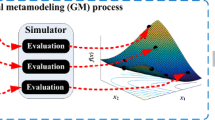Abstract
Metamodels for simulators are used to reduce computational costs in engineering system design. In general, metamodels have different fit accuracy levels over different regions in the design variables space, especially for highly nonlinear responses over wide spaces. A metamodeling strategy should place less emphasis on sub regions in the design variables space requiring relatively less complex metamodels. In this paper, we present a graphically based methodology that can be used to partition the space for piecewise metamodel building. The method is based on analyzing an initial global metamodel for acceptability in terms of prediction accuracy over the whole space; then generating acceptance score distribution (ASD) plots. Visual inspection of the ASD plots is used as a guidance to partition the design variables space, leading to a metamodel with fair prediction accuracy on a piece-by-piece basis, not just globally on average. The proposed methodology is general and can be applied to various metamodel types. It is tested on a number of problems, including some of the most highly nonlinear test problems used in the literature.












Similar content being viewed by others
Notes
It may be appropriate to suggest here the use of a shift transformation on data points having an unacceptable number of data points with zero response if it is planned to use ASD plots. The shift transformation is achieved by adding a constant to each response value, such that all responses in the validation sample become positive.
Note that if each of the six variables is varied using three levels for each for a second-order polynomial metamodel then a uniform design with 36 = 729 design points is obtained.
References
Vladimirescu A (1994) The SPICE book. Wiley, New York
Kleijnen J. Regression models and experimental design: a tutorial for simulation analysts. http://www.center.kub.nl/staff/kleijnen/papers.html (accessed 15 Nov. 2006)
Angün E, Kleijnen J, Hertog D, Gürkan G (2002) Response surface methodology revisited. In: Proceedings 2002 Winter Simulation Conference, pp 377–383
Jin R, Chen W, Simpson T (2001) Comparative studies of metamodeling techniques under multiple modeling criteria. Struct Mutidisc Optim J 23:1–13
Martin J, Simpson T (2005) Use of kriging models to approximate deterministic computer models. Am Inst Aeronaut Astronaut J 43:853–863
Friedman J (1991) Multivariate adaptive regression splines. Ann Stat 19:1–141
Shin M, Sragent R, Goel A (2002) Gaussian radial basis functions for simulation metamodeling. In: Proceedings 2002 Winter Simulation Conference, pp 483–488
Hendrickx W, Dhaene T (2005) Sequential design and rational metamodeling. In: Proceedings 2005 Winter Simulation Conference, pp 290–298
Clarke S, Griebsch J, Simpson (2005) Analysis of support vector regression for approximation of complex engineering analyses. J Mech Des 127:1077–1087
Barton R (1998) Simulation metamodels. In: Proceedings 1998 Winter Simulation Conference, pp 167–174
Draper NR, Smith H (1981) Applied regression analysis. Wiley, New York
Sargent R (2004) Validation and verification of simulation models. In: Proceedings 2004 Winter Simulation Conference, pp 13–24
Kleijnen J, Deflandre D (2006) Validation of regression metamodels in simulation: bootstrap approach. Eur J Oper Res 170:120–131
Barton R R (1999) Graphical methods for the design of experiments. Springer, Heidelberg
Hamad H, Al-Hamdan S (2005) Two new subjective validation methods using data displays. In: Proceedings 2005 Winter Simulation Conference, pp 2542–2545
Hamad H, Al-Hamdan S (2007) Discovering metamodels’ quality-of-fit via graphical techniques. Eur J Oper Res. 178(2):543–559
Hamad H (2006) A new metric for measuring metamodels quality-of-fit for deterministic simulations. In: Proceedings 2006 Winter Simulation Conference, pp 2542–2545
Guinta A, Wojtkiewicz S, Eldred M (2003) Overview of modern design of experiments methods for computational simulations. In: Proceedings 41st Aerospace Sciences Meeting and Exhibit, AIAA-2003-649
Kalagnanam R, Diwekar U (1997) An efficient sampling technique for off-line quality control. Technometrics 39:308–319
Meckesheimer M, Booker A (2002) Computationally inexpensive metamodel assessment strategies. Am Inst Aeronaut Astronaut J 40:2053–2060
Otto J, Paraschivoiu M, Yesilyurt S, Patera A (1997) Bayesian-validated computer-simulation surrogates for optimization and design: error estimates and applications. IMACS J Appl Numer Math 44:347–367
Yesilyurt S, Patera A (1995) Surrogates for numerical simulations; optimization of Eddy-promoter heat exchangers. Comput Methods Appl Mech Eng 121:231–257
Otto J, Landman D, Patera A (1996) A Surrogate approach to the experimental optimization of multielement airfoils. In: 6th AIAA/USAF/NASA/ISSMO Symposium on Multidisciplinary Analysis and Optimization, 2:1323–1333 (AIAA-96–4138-CP)
Otto J, Paraschivoiu M, Yesilyurt S, Patera A (1995) Bayesian-validated computer-simulation surrogates for optimization and design. In: Proceedings of the ICASE/NASA Langley Workshop on Multidisciplinary Optimization, pp 368–392.
Oppenheim A, Schafer R (1989) Discrete-time signal processing. Prentice-Hall, Englewood Cliffs
Box G, Draper N (1959) A basis for the selection of a response surface design. Am Stat Assoc J 54:622–654
Draper N (1960) Second order rotatable designs in four or more dimensions. Ann Math Stat 31:23–33
Draper N, Lawrence W (1965) Designs which minimize model inadequacies: cuboidal regions of interest. Biometrica 52:111–118
Hershenson M, Boyd S, Lee T (2001) Optimal design of a CMOS op-amp via geometric programming. IEEE Trans Comput Aided Des 20:1–21
Author information
Authors and Affiliations
Corresponding author
Additional information
Professor Adnan Al-Smadi is currently on sabbatical leave.
Rights and permissions
About this article
Cite this article
Hamad, H., Al-Smadi, A. Space partitioning in engineering design via metamodel acceptance score distribution. Engineering with Computers 23, 175–185 (2007). https://doi.org/10.1007/s00366-007-0056-z
Received:
Accepted:
Published:
Issue Date:
DOI: https://doi.org/10.1007/s00366-007-0056-z




